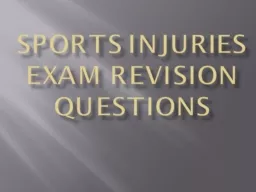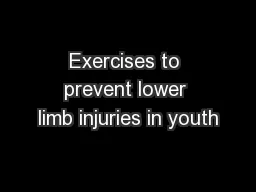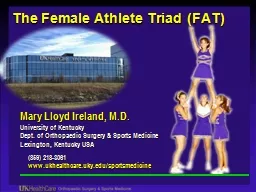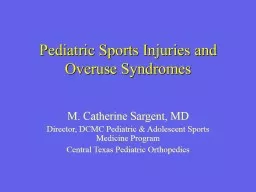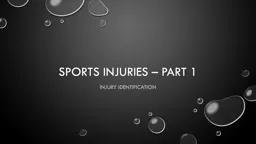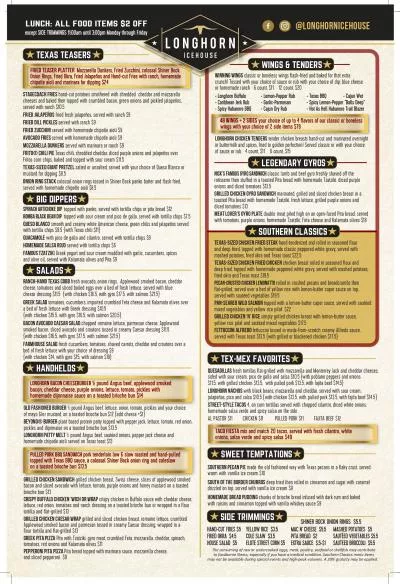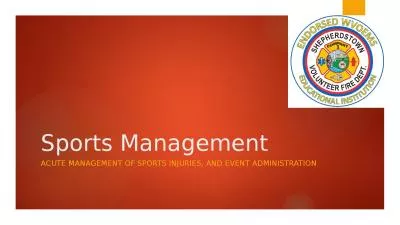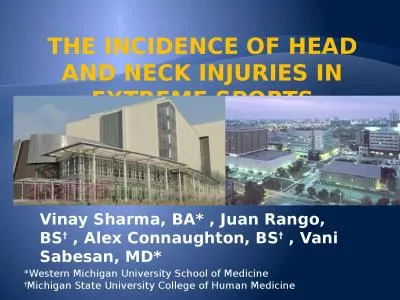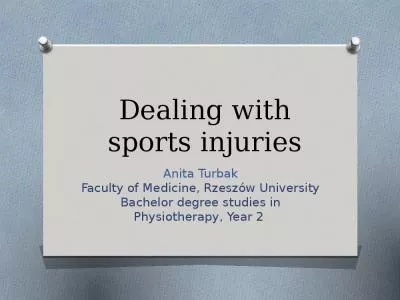PPT-Sports Injuries
Author : min-jolicoeur | Published Date : 2016-07-16
Exam Revision Questions A basketball player twists their ankle in a game and has to leave the court a Describe the immediate treatment that they should use 4 marks
Presentation Embed Code
Download Presentation
Download Presentation The PPT/PDF document "Sports Injuries" is the property of its rightful owner. Permission is granted to download and print the materials on this website for personal, non-commercial use only, and to display it on your personal computer provided you do not modify the materials and that you retain all copyright notices contained in the materials. By downloading content from our website, you accept the terms of this agreement.
Sports Injuries: Transcript
Exam Revision Questions A basketball player twists their ankle in a game and has to leave the court a Describe the immediate treatment that they should use 4 marks b The injury does not respond to the treatment Describe two other treatments that could be used to help recovery 3 marks. What Clinicians Need To Know. Northeastern. University . Contents . Objectives. Introduction . Risk Factors. Common Injuries . Prevention. Treatment. Recommendations. What Clinicians Can DO. References. Lauren Shull, MD-R. PGY-3. The theory of sport specialization is based on an interpretation of a study done by Ericsson. In his study, how many hours of practice were thought to be required to reach mastery level of a skill? . and Your Feet. Dr. Dennis R. Frisch. Boca Raton Podiatry. 30 SE 7. th. St. Boca Raton, FL 33432. Benefits of Exercise. Cardiovascular Health. Mental Health. Overall Health. Disease Prevention. Management of Diseases . Kale Hintz & Emily Metschke. Introduction. Target Population- Youth involved in sport. Why?. 21.5 million between 6 and 17. 1.35 million serious injuries per year. 24% are lower limb injuries. Experiment. Dr. Howard C H Chen. Athlete’s Care Sports Medicine Centres. Faculty/Presenter Disclosure. Faculty: Dr. Howard C. H. Chen. Relationships with commercial interests . Not Applicable. Relationships with commercial interests. Mary Lloyd Ireland, M.D.. University of Kentucky. Dept. of Orthopaedic Surgery & Sports Medicine. Lexington, Kentucky USA. (859) 218-3061 . www.ukhealthcare.uky.edu/sportsmedicine. . The Female Athlete Triad. Wise to Specialize?. Brian Purchase, DO, FACOEP, CAQ Sports . Medicine. Covenant Sports Medicine. Goals and Objectives. Define Sports . Specialization. Why is it important?. What should we do and recommendations?. M. Catherine Sargent, MD. Director, DCMC Pediatric & Adolescent Sports Medicine Program. Central Texas Pediatric Orthopedics. Disclosure. No financial or material support has been received from any commercial enterprise.. Injury Identification. Identification on Injury . Sports injuries can be caused by a fall or a heavy blow; failing to warm up properly, use equipment properly or use the correct technique; or simply by pushing yourself too hard. . Concussions are a type of traumatic brain injury (TBI) caused by a blow or jolt to the head. Concussions can be mild or severe and interfere with the way the brain normally works, Sometimes symptoms This is the January 2023 menu for Longhorn Icehouse, a sports bar in Dallas located at 1901 W Northwest Hwy, Dallas, TX 75220 (Phone: 972-707-0884). Longhorn has dozens of large screen TVs for watching sports, fight nights (UFC or boxing), is the official watch party venue for several teams with large fan bases, has pool tables and basketball hoop games and a wide range of beers and drinks available. Happy hour every day, late night kitchen open until midnight (convenient for those arriving late at DFW Airport or Love Field Airport), private room with overhead projector (seating up to 75 people), and a stage with large screen for live music or even awards presentations. Visit: https://www.longhornicehouse.com/dallas-sports-bar-dining/ Objectives. Prepare . you to act . so . the athletes can receive appropriate care and treatment in the case of an emergency. . The secondary purpose is for the overall event management.. Clinical Competence. Vinay Sharma, BA* , Juan Rango, BS. †. , Alex Connaughton, BS. †. , Vani Sabesan, MD*. *Western Michigan University School of Medicine. †. Michigan State University College of Human Medicine. Anita . Turbak. Faculty of Medicine, . Rzeszów. University. Bachelor degree studies in Physiotherapy, Year 2 . Aims of physiotherapy after sport . inju. ry. treat . and fully rehabilitate . the person.
Download Document
Here is the link to download the presentation.
"Sports Injuries"The content belongs to its owner. You may download and print it for personal use, without modification, and keep all copyright notices. By downloading, you agree to these terms.
Related Documents

